Support 2023
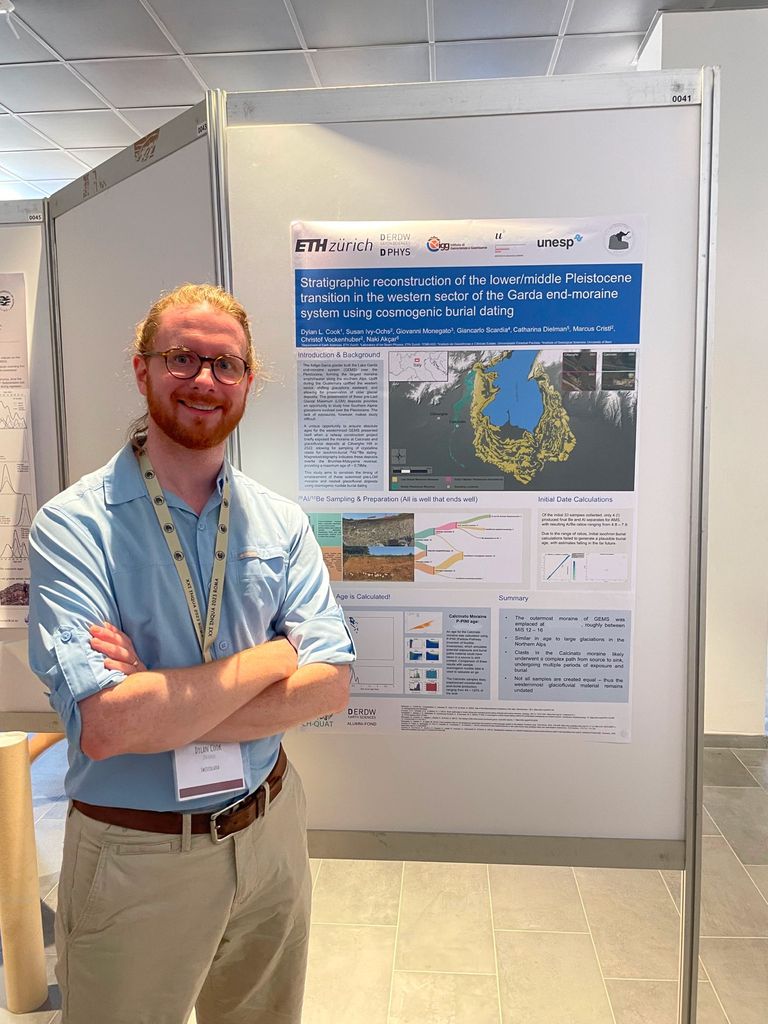
Dylan Cook | Geology | ETH Zürich
Reconstructing the Middle Pleistocene in the Garda end-moraine system with cosmogenic 26Al – 10Be burial dating (Lake Garda, Northern Italy)
The Lake Garda end-moraine system, located in Northern Italy, is one of the most extensive moraine amphitheaters along the Southern Alps. While the chronology of the Last Glacial Maximum within the Garda end-moraine system has been well-described, the timing of emplacement of pre-Last Glacial Maximum moraines and glacial features remains poorly constrained, limited to stratigraphic correlation and paleomagnetic dating.
My MSc thesis applied cosmogenic 26Al – 10Be burial dating to provide the first absolute age for a Middle Pleistocene moraine in the Garda end-moraine system. Field work and sample collection occurred in the spring and summer of 2022, followed by sample purification and quartz purification for measurement of cosmogenic 26Al and 10Be. Initial calculations of a burial age began in early summer 2023.
With support from CH-QUAT, the preliminary results of this research were presented as a poster, “Stratigraphic reconstruction of the lower/middle Pleistocene transition in the western sector of the Garda end-moraine system,” at INQUA 2023 Roma. As this is one of the first burial ages for glacial deposits along the Southern Alps, presenting at INQUA provided an excellent opportunity to announce this work, and also provided an amazing opportunity for me to see and discuss a wide variety of Quaternary research from across the globe. I am incredibly grateful to CH-QUAT for making this possible!
Contact: Dylan Cook (dycook@student.ethz.ch)
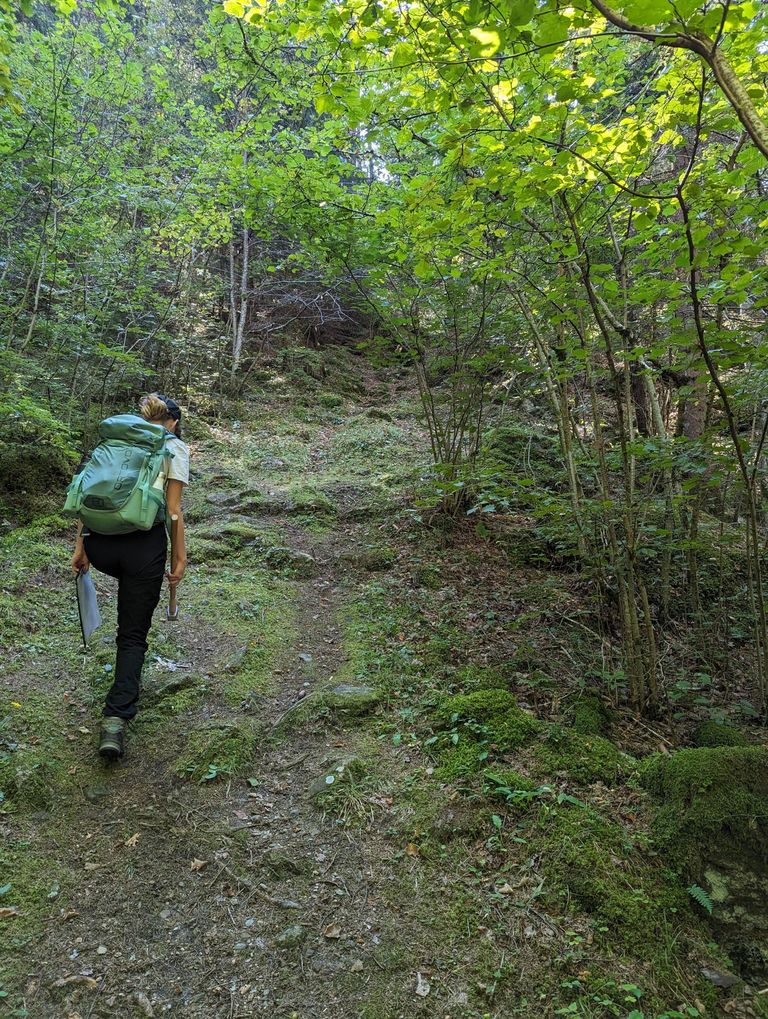
Janine Fankhauser | Institute of Geological Sciences | Universität Bern
Timing of the Poschiavo Rock Avalanche
Rock avalanches and glaciations often go hand in hand with each other. There have been several glaciations throughout the Quarternary which destabilize the bedrock and therefore cause rock avalanches. One example of this interaction is found in the Poschiavo valley in canton of Graubünden.
My research focuses on this rock avalanche. The aim is to date and model the Poschiavo rock avalanche in order to reconstruct the events that led to todays landscape. Suitable Boulders need to be mapped and dated with cosmogenic 10Be. Furthermore, with the help of an unmanned air vehicle, aerial images will be taken to support mapping inaccessible outcrops on steep slopes. After the mapping and dating, the rock avalanche will be modeled.
With the financial support of CH-QUAT, I was able to start mapping suitable boulders of the Poschiavo rock avalanche. Based on this first examination, we will later be able to sample the boulders and date them with cosmogenic 10Be.
I am very grateful for the support from CH-QUAT and making this research possible!
Contact: Janine Fankhauser (janine@fankhauser.cc)
Lena Camenzind | Institute of Geological Sciences | Bern, Switzerland
Evolution of the Polygenetic Le Pont Cone, The Ferret Valley, Mont Blanc Massif
The topography of the Mont Blanc Massif is characterized by a significant elevation gap between the valley floors and the mountain peaks. This gap, in combination with different processes such as the glacial, amplifies the recurrence of natural hazards in this deeply carved landscape. Not only the inhabitants of the valley but also tourism and the population in the region, are under the permanent threat of natural hazards such as the rock avalanches. By studying past mass movements in detail, return periods and the extent of gravitational processes can be determined. This can help make better predictions for natural hazards. For example, there are several polygenetic cones, a product of a complex interaction of slope, glacial and/or fluvial processes, in the northern slope of the Ferret Valley, Courmayeur, Italy.
This study focuses on the Le Pont cone who is of polygenetic origin and built-up of rock avalanche, debris flow, and glacial deposits. However, the extent and timing of deposition of these sediments remain unknown. As a result, the main objective of this study is to reconstruct the evolution of the Le Pont cone and establish a timeline for the deposition events. During the reconnaissance fieldwork, we found that the Le Pont cone is mainly made up of rock avalanche and debris flow sediments.
The support of CH-QUAT allowed me to do a week of fieldwork in Le Pont, and I was able to map the cone in detail and mark all the suitable boulders for dating with 10Be. Later on we will sample the boulders and date them. In addition, the rock avalanche will be reconstructed, and the failure will be modeled. Finally, all results, combined with existing studies, will be reconciled into a landscape evolution model of the Ferret Valley.
I would like to thank the CH-QUAT for supporting my fieldwork and covering the cost of my accommodation. I am looking forward to seeing the results. Thank you!
Contact: Lena Camenzind (lena.camenzind@students.unibe.ch)
Pierre Lapellegerie | Geoecology Research Group | Department of Environmental Sciences | University of Basel, Switzerland
Attendance at INQUA 2023, Rome, Italy
INQUA is an international congress held every four years which aims at bringing together people working on the Quaternary. This year the congress took place from the 14th to the 20th of July at the University of La Sapienza in Rome. The congress held 1480 talks and 2114 poster presentations.
At this congress I was able to present one project of my PhD, which was entitled: “A 35ka chironomid record and summer temperature reconstruction covering the Last Glacial Maximum from Bergsee (Black Forest, Germany)”. The focus of my work was to look at the changes in the chironomid community in a long sediment record in Central Europe. During the Last Glacial Maximum, Bergsee was located between the Black Forest glacier and the Alpine glaciers and stayed free of ice. This suggests that the lake has probably recorded the entire Last Glacial Period, making it a unique lake archive in Central Europe. We used the chironomid assemblages to quantitatively reconstruct July air temperature between 9 and 45ka. Based on the chironomid assemblages the coldest period seems to have been between 23-25ka when the cold stenotherm Sergentia coracina-type occurred and the diversity of the chironomid assemblage was at its lowest with temperatures around 11°C.
Thanks to the financial support of CH-QUAT I was able to go to the congress to introduce my work to other scientists working on the same topics and to get helpful feedback on my project. I was also able to establish new contacts and learn a lot of tools that I could use in my work. Thank you CH-QUAT!
Contact: Pierre Lapellegerie (pierre.lapellegerie@unibas.ch)
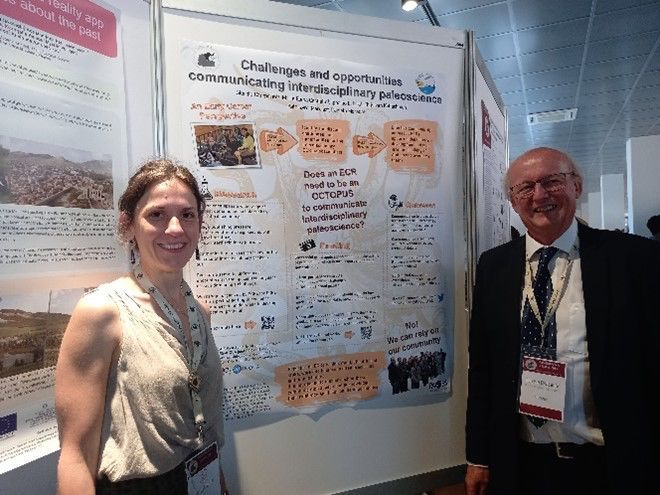
Giorgia Camperio | Department Surface Waters Research & Management | EAWAG
Participation at INQUA Congress 2023 with CH-QUAT's Support
The CH-QUAT funding for young researchers supported my attendance at the XXI INQUA Congress "Time for Change" held at Sapienza University, Rome, Italy on 14-20 July 2023. Happening every 4 years, this is one of the most important meeting for quaternary scientists. More than 3000 researchers gathered this year! Here I presented an overview of the main findings of my doctoral project with an oral presentation titled “Vanuatu cultural landscapes across time and space”. For the presentation, I focused on the molecular markers found in the sedimentary records of ponds located in the West Coast of the Island of Espiritu Santo and one peat core we retrieved from the Island of Efate near one of the most famous archaeological sites for the Lapita culture, who are considered the first colonizers of Remote Oceania. Thanks to a high-resolution radiocarbon dating of the sediment core, I could show how human associated markers are most abundant during period of archaeological known early human occupation and how these co-vary with period of hydroclimatic changes (from dry to wet). The presentation was followed by a questions and answers part, which gave me the opportunity to expand the discussion on the biomarker we used in the project as well more broadly on the study site. Through the feedbacks and comments from the broad audience, I could get experts’ insights that can only be shared during such invaluable in person meetings.
At the congress I also had the chance to present a poster titled “Challenges and opportunities communicating interdisciplinary paleoscience” which was the result of a discussion held during the for Early Career Researchers workshop on Past Socio Environmental Systems workshop held in La Serena, Chile, in November 2022.
The many sessions I attended at INQUA and the side social events were unique occasions to meet colleagues (and friends), strengthen my international network, discuss upcoming projects and set the ground for future collaborations. I am grateful to the CH-QUAT for the possibility to participate to such a pivotal event in my career, a great boost of enthusiasm and motivation for the final run of my doctoral project.
Contact: Giorgia Camperio (Giorgia.Camperio@eawag.ch)
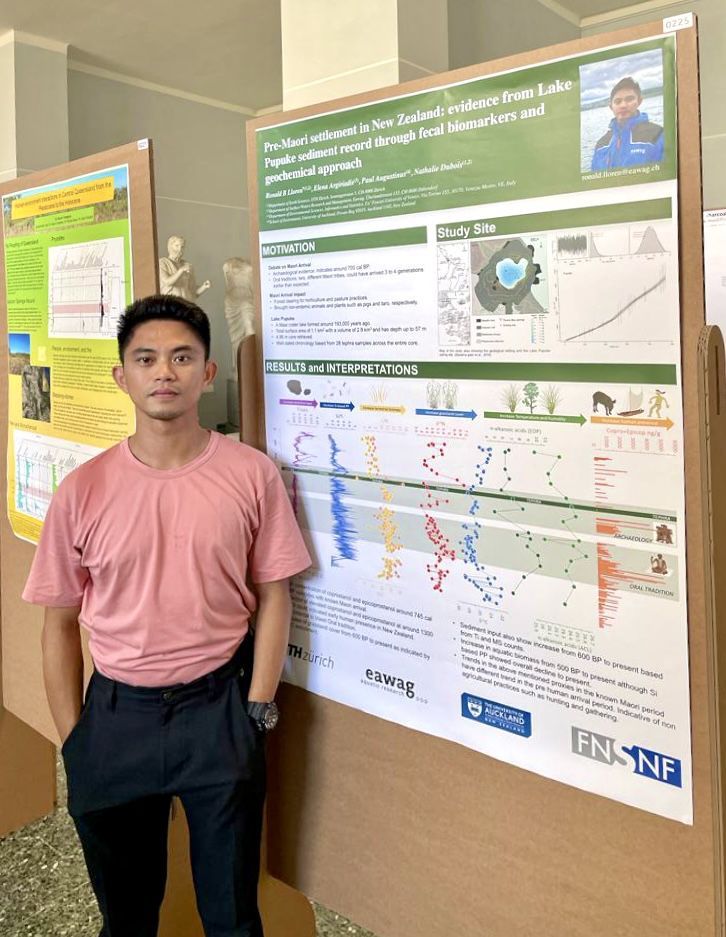
Ronald Lloren | Earth Science Department, ETHZ Zürich | SURF Department, Sedimentology Group, EAWAG
Poster Presentation and Participation at INQUA Congress 2023 with CH-QUAT's Support
The INQUA (International Union for Quaternary Research) congress is a gathering of thousands of scientists across the world who study the entire Quaternary period through a wide range of interdisciplinary research fields. This conference takes place every 3 to 4 years. This year, it was held in Rome, Italy, from 13th of July to the 20th with the theme: “Time for Change”.
I am profoundly grateful to the Swiss Society for Quaternary Research (CH-QUAT) for their financial support. This support enabled me to present my work on the timing of human arrival in New Zealand as poster presentation. My work utilizes molecular biomarkers, various sedimentological, and geochemical proxies to gain a deeper understanding of the timing of human settlement on the Northern Island of New Zealand, using a lake sediment record taken from Lake Pupuke.
My poster presentation received a considerable amount of positive feedbacks and discussions that will enhance the robustness of my interpretations. In addition to the poster presentation, I had the opportunity to engage with other early career researchers and professors, leading to valuable discussions that advance knowledge in Quaternary research and lay the groundwork for future collaborations.
My attendance at the congress proved to be incredibly fruitful and successful. Once again, I extend my gratitude to CH-QUAT for their support.
Contact: Ronald Lloren (ronald.lloren@eawag.ch)
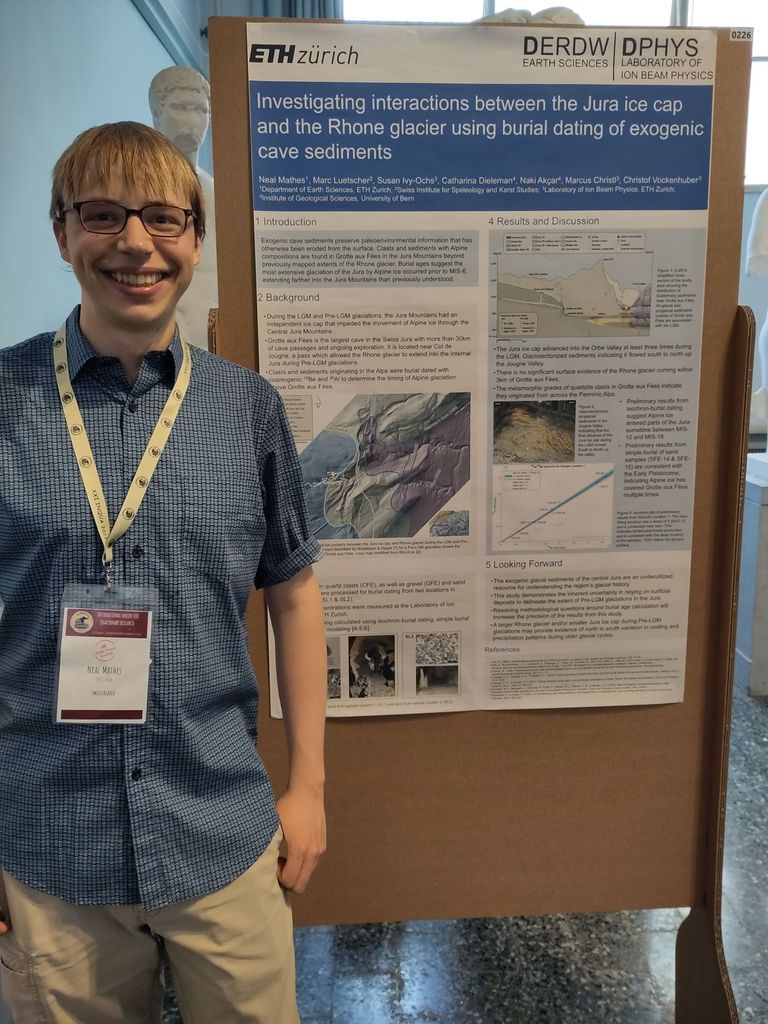
Neal Mathes | Department of Earth Sciences | ETH Zürich, Switzerland
Attendance and poster presentation at the INQUA Congress in Rome, Italy
The International Union for Quaternary Research (INQUA) hosts a congress once every four years where thousands of researchers from across the globe can meet to discuss the latest developments in Quaternary research. This year, the conference was held at Sapienza University of Rome, Italy between July 13-20 and consisted of over 200 presentation sessions and hundreds of posters.
With the financial help provided by CH-QUAT’s Support for Young Researchers, I was able to attend INQUA Roma and present a poster with information about my ongoing master’s thesis. The poster’s title was “Investigating interactions between the Jura ice cap and the Rhone glacier using burial dating of exogenic cave sediments”. My thesis work has centered on understanding glacial sediments of Alpine origin found in Grotte aux Fées, a cave in the Central Jura Mountains of Switzerland. Quartz bearing sediments have been dated with cosmogenic 10Be and 26Al using simple burial dating, isochron-burial dating, and P-PINI modeling techniques. This dating, combined with investigation of above ground Quaternary sediments, is providing new insights into the timing and extents of the LGM and Middle Pleistocene glaciations of the Northern Alpine Foreland.
Thank you to CH-QUAT and the members of the Swiss geoscience community for supporting my research and providing the funding that allowed me to attend the INQUA Congress. It was a wonderful experience to share my work with, and receive feedback from, the broader Quaternary research community.
Contact: Neal Mathes (nmathes@student.ethz.ch)
Ieva Grudzinska-Elsberga | Geoecology Research Group | Department of Environmental Sciences | University of Basel, Switzerland
Support to cover participation fee for INQUA 2023
Quaternary researchers from all over the world gathered at the XXI INQUA Congress "Time for Change" at Sapienza University, Rome, Italy on 14-20 July 2023. Thanks to the support of CH-QUAT, I had the opportunity to be one of the 2783 delegates and present my research on the impact of anthropogenic pollution on Wohlensee (Canton Bern) and its recovery. In this study, several paleolimnological methods were applied including diatom and chironomid analyses, which are widely used as indicators of water quality. The study shows that chironomids and diatoms in Wohlensee have been strongly affected by organic pollution and nutrient release during the 20th century with maximum effects in the 1950s-1960s. The lake has since recovered, but assemblages of chironomid and diatom species in the youngest samples are still different from the original fauna and flora observed in Wohlensee immediately after the 1920 completion of the dam forming the Wohlensee. This suggests that at the time of coring (in 2014) the ecosystem had not yet returned to its original state, although the observed taxa indicate a similar water quality as after the creation of the lake.
On Wednesday (July 19th) during the poster presentation (Picture 1) of the Session 14 “Climate and environmental changes during the Holocene and past interglacials based on biological and geochemical proxies”, I had a chance to discuss the results of the Wohlensee study with colleagues from various countries (Algeria, Argentina, Germany, Iceland, etc.) who are also working with similar proxies as chironomids and diatoms.
During the Congress we experienced two heat waves, Cerberus and Charon. In the second wave, on July 18th, while the Congress was in full swing, a new record for the highest measured temperature in Rome was set at 41.8°C, breaking the previous record of 40.5°C set in summer 2007. Experiencing scorching temperatures, we discussed how climate change will affect our future and how, unfortunately, such heat waves will happen more and more often. Despite the uncomfortable weather, the participants remained in high spirits and the saying "Rome is hot, but INQUA is cool" was heard very often.
I would like to thank CH-QUAT very much for supporting me, I greatly appreciate the organisation for giving me this opportunity.
Contact: Ieva Grudzinska-Elsberga (ieva.grudzinska-elsberga@unibas.ch)
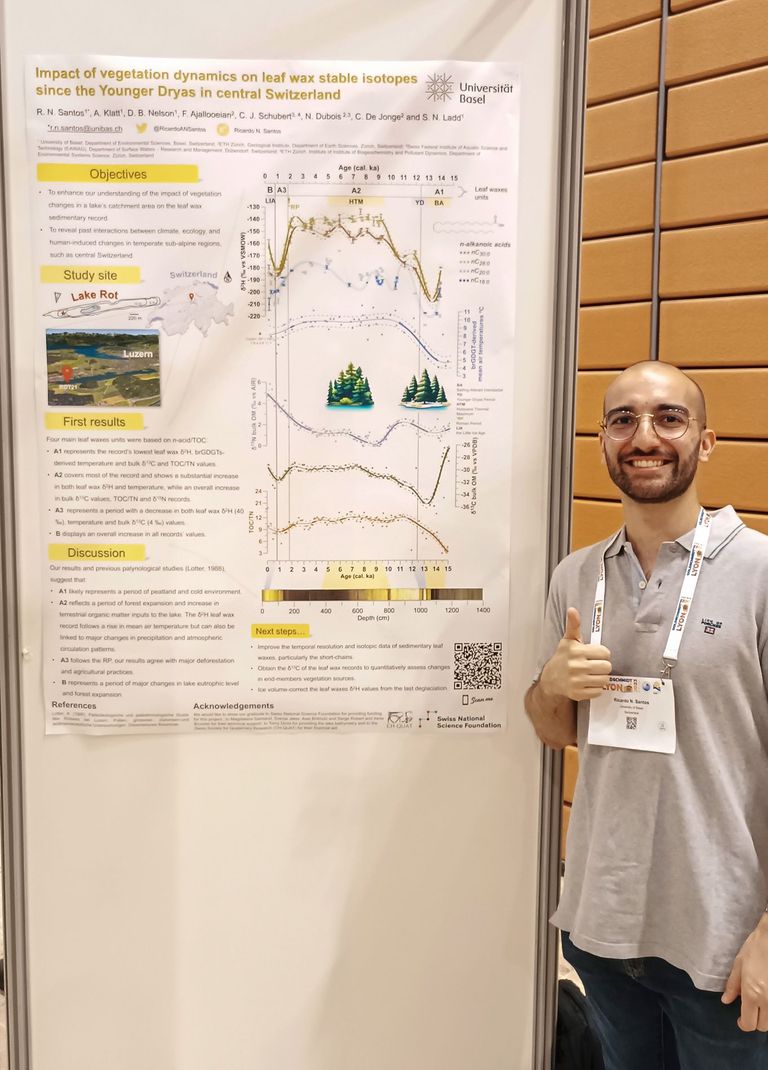
Ricardo N. Santos | Organic Geochemistry Group | Department of Environmental Sciences | University of Basel, Switzerland
Unveiling past conditions using leaf wax stable isotopes
My research focuses on molecular paleoclimatology, specifically isotopic values of lipid biomarkers as tools for determining past climate and environmental changes. My PhD research at the University of Basel is focused on reconstructing and comprehending the complex interplay of climate, vegetation cover, and human-induced change in subalpine and temperate regions.
I’m glad for the opportunity to present our first long-term lipid biomarkers of Rotsee record (Luzern, Switzerland) at this year’s Goldschmidt23 conference in Lyon (France) under the title ‘Impact of vegetation dynamics on leaf wax stable isotopes since the Younger Dryas in central Switzerland’. This was my first major in-person conference, and it allowed me to not only share the research we are doing at ADAPT project (Algal Dynamics And Productivity through Time) but also connect with other fellow scientists and gain valuable feedback and insights. I am grateful to the Swiss Society for Quaternary Research for providing financial assistance to help me cover some of the costs associated with my attendance.
Contact: Ricardo N. Santos (r.n.santos@unibas.ch)
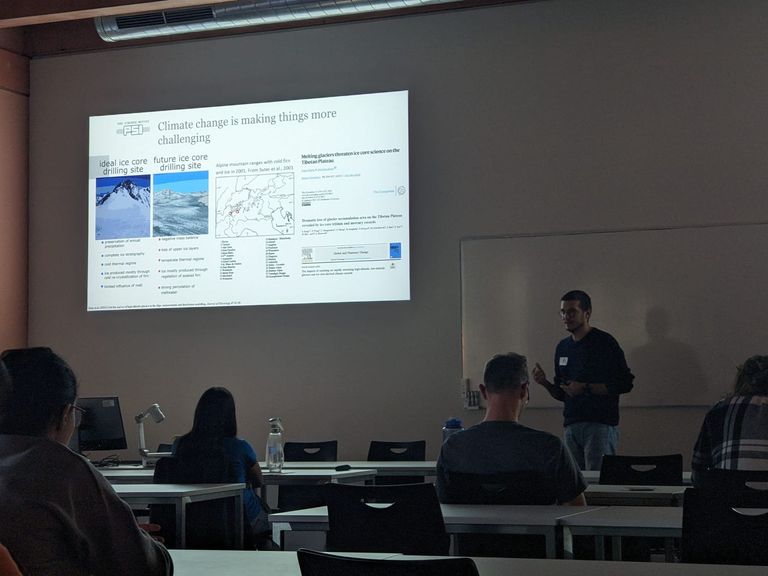
Giovanni Baccolo – Paul Scherrer Institute – Villigen, Switzerland
Exploring the potential of temperate glaciers as paleoclimatic
archives
Glaciers are strictly controlled by meteorological and climatic parameters, as both snow accumulation and ablation strongly depend on them. As such, glaciers are strongly reacting to the anthropogenic perturbation of the climate system. Increased melt rates and reduced snow accumulation are responsible for their global retreat.
Climate change is not only affecting the size and geometry of glaciers, but also their thermal properties. In many areas of Earth, the upper part of glaciers is transitioning from a cold thermal regime, to a temperate one. This mean that the temperature of ice and snow from being constantly below 0° (cold condition) is approaching the melting point (temperature condition).
Ice core science has traditionally focused on cold accumulation basins for drilling glaciers, as they are not affected by melting and allow the best preservation of the stratigraphic signals used for paleoclimatic reconstructions. But due to climate change, the coldest portions of glaciers are getting smaller or even disappearing. This is posing issues on the ability of glaciers to preserve climatic and environmental signals. Melting is erasing the upper ice layers, obliterating the most recent signals normally used for calibration with instrumental data. At the same time the increased presence of meltwater affects the preservation of signals in the temperate portions of glaciers.
The exploitation of mountain glaciers as paleoclimatic archives in the near future will only be possible if the ice core science community develops new methods and competencies to extract information from temperate ice addressing meltwater disturbances. Exploring this possibility is my current research topic. I am studying a temperate ice core drilled in the Southern Rhaetian Alps (Adamello) to address if and to what extent temperate glaciers can be exploited as paleoclimatic archives. I am looking forward to tell more about my project, but I can anticipate that yes, temperate ice can still record some information about the climate and environment.
I have presented the first results of my research at the 2023 Swiss Geoscience Meeting. This was possible thanks to the support provided by CH-QUAT.
Contact: Giovanni Baccolo (giovanni.baccolo@psi.ch)